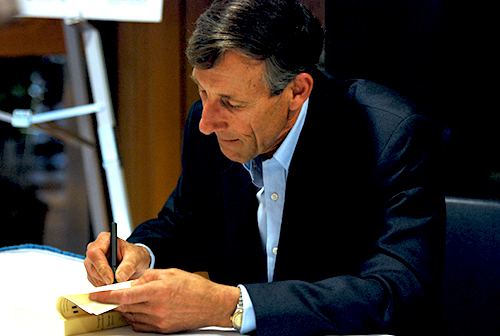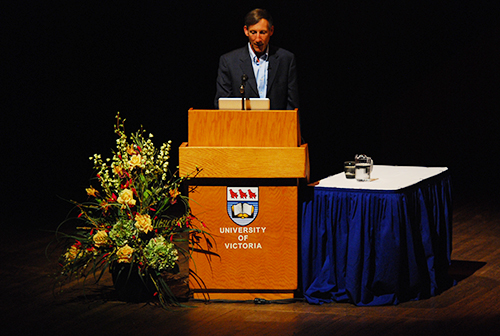Andrina Fawcett http://twitter.com/thecardigangirl
George Dyson, this year's final Big Thinking speaker, marked the transition from Congress 2013 to the Digital Humanities Summer Institute (DHSI) here at UVic. As Dr. Raymond Siemens, director of the DHSI, so aptly stated in his introduction, “Dyson has a remarkable capacity to humanize and render in human terms our engagements with technology.”
Kayak builder, historian, author, and once-upon-a-time tree house dweller, Dyson spoke of early computing legends as being very adult in their thinking as children, and very childlike in their thinking as adults: a charming trait that perhaps Dyson himself could be considered to possess. It’s that spirit of exploration that Dr. Siemens attributed to maker practice and Dyson’s life: “through building things we seek to understand. George makes to learn, and learns though making.”
In the presentation, “The first five kilobytes are the hardest," George Dyson illuminated the focus of his latest work Turing’s Cathedral. Leading the crowd through the evolution of computing over the last century, he focused primarily on a small group of men and women, led by John von Neumann at the Institute for Advanced Study in Princeton, New Jersey, who built one of the first computers to implement Alan Turing’s vision of a Universal Machine. The idea of a Universal Machine, developed by Turing in 1936, has "been realized in every iPhone” Dyson explained.
The computer at Princeton utilized only five kilobytes of memory, and the team would use it to pursue such topics as nuclear weapons and weather prediction; however, they still managed to find time to maintain a healthy rivalry with the Humanities department on the amount of sugar being used in their teas. For comparisons sake, it is important to note that your last dull email, or even this blog post itself exceeds this measurement, but it was only five kilobytes of memory that was used to build Ivy Mike, the 10.2-megaton bomb.
A personal favorite of the presentation was when Dyson shared photos of the lab notes kept by the computing team. One of these photos was simply a page that just said in full caps “TO HELL WITH IT!” – a sentiment of frustration that perhaps many can relate to in their experience with computers.
Fast forward to a world where terabytes of data (a terabyte is in excess of one billion kilobytes) are being collected regularly for projects such as surveying the night sky: “Big data is what happened when the cost of storage became less than the cost of throwing the data away,” Dyson said.
But where will computing go from here? Dyson believes that much in the same way that John von Neuman’s transition from paper tape systems to the two dimensional matrix used in computers today, there will be a similar transition in the years to come to a three dimensional system.
In 1953, only 53 kilobytes of high-speed memory existed on the planet – but as Dyson commented “you could use all of that in one email today that says almost nothing.”


